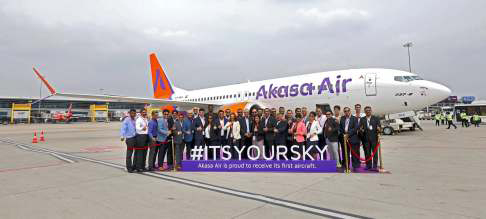Airlines in India on record aircraft buying spree as country’s economy hits 5th largest in the world
- Air India orders 470 aircraft, mix of Airbus and Boeing
- IndiGo to acquire 500 planes, in partnership with Turkish Airlines
- Akasa Air indicates three-digit orders
By R. Chandrakanth
India is now the runway to more than a billion opportunities. A decade ago, the country’s GDP ranked 11th in the world but is now the5th largest, even surpassing the United Kingdom’s economy, according to the International Monetary Fund.
The World Bank forecasts the Indian economy to grow by 6.9 percent in 2023 fiscal year and efforts are on to achieve the Prime Minister’s ambitious goal of achieving USD $5 trillion economy by 2025.
The drivers are many, including a government which has business-friendly policies in place, across verticals. With the present dispensation giving importance to creation of infrastructure – airports for instance – the aviation sector in India is energized.
Another important decision the government took was to hive off the beleaguered national carrier – Air India—to the Tata Group which emerged as the successful bidder of the divestment process.
Tata Group won the Air India bid in October 2021, getting ownership of iconic brands like Air India, Indian Airlines & the Maharajah. Air India then had a fleet of 117 wide-body and narrow-body aircraft and AIXL a fleet of 24 narrow-body aircraft.
Tata Group overhauling beleaguered Air India
The Tata Group has a major job on hand overhauling the loss-making airline. It has begun in right earnest. In a little over a year, on February 14, 2023, Air India announced that it has signed letters of intent with Airbus and Boeing to acquire both widebody and single-aisle aircraft.
The order comprises 40 Airbus A350s, 20 Boeing 787s and 10 Boeing 777-9s widebody aircraft, as well as 210 Airbus A320/321 Neos and 190 Boeing 737 MAX single-aisle aircraft. The A350 aircraft will be powered by Rolls-Royce engines, and the B777/787s by engines from GE Aerospace. All single-aisle aircraft will be powered by engines from CFM International.
Modern, efficient fleet fundamental to transformation: Tata Chairman
Commenting on the occasion, Tata Sons and Air India Chairman, Mr. N. Chandrasekaran, said: “Air India is on a large transformation journey across safety, customer service, technology, engineering, network and human resources. Modern, efficient fleet is a fundamental component of this transformation. This order is an important step in realising Air India’s ambition, articulated in its Vihaan.AI transformation program, to offer a world class proposition serving global travellers with an Indian heart. These new aircraft will modernise the Airline’s fleet and onboard product, and dramatically expand its global network. The growth enabled by this order will also provide unparalleled career opportunities for Indian aviation professionals and catalyse accelerated development of the Indian aviation ecosystem.”
The first of the new aircraft will enter service in late-2023, with the bulk to arrive from mid-2025 onwards. In the interim, Air India has already started taking delivery of 11 leased B777 and 25 A320 aircraft to accelerate its fleet and network expansion.
The acquisition of new aircraft, which will come with an entirely new cabin interior, complements Air India’s previously announced plan to refit its existing widebody B787 and B777 aircraft with new seats and inflight entertainment systems. The first of these refitted aircraft will enter service in mid-2024.
 Air India to hire over 4,200 cabin crew
Air India to hire over 4,200 cabin crew
In line with its aircraft acquisition plans, Air India announced plans to hire over 4200 cabin crew trainees and 900 pilots in 2023. The cabin crew, who will be recruited from around the country, will undergo a 15-week programme imparting safety and service skills, and will be coached to exemplify the best of Indian hospitality and Tata group culture.
Notably, between May 2022-February 2023, Air India hired over 1900 cabin crew. Over 1,100 cabin crew have been trained in the last seven months (between July 2022-January 2023), and in the past three months, approximately 500 cabin crew have been released for flying by the airline.
The Air India group currently comprises full-service Air India, as well as two low-cost subsidiaries Air India Express and Air Asia India which are in the process of merging. Its parent, Tata Sons, recently announced its intention to merge Air India with full-service airline Vistara, a joint venture between Tata Sons and Singapore Airlines in which the former holds a 51% share. In steady state, subject to regulatory approval, the Group would comprise a single full-service airline, Air India, and a single low-cost airline, Air India Express.
After 69 years as a governmentowned enterprise, Air India and Air India Express were welcomed back into the Tata group in January 2022. The present management at Air India, led by CEO and Managing Director, Campbell Wilson who took over in June 2022, is driving the five-year transformation roadmap under the aegis of Vihaan.AI to establish itself as a world-class global airline with an Indian heart.
Vihaan.AI is Air India’s transformational roadmap over five years with clear milestones. It will be focussing on dramatically growing both its network and fleet, developing a completely revamped customer proposition, improving reliability and on-time performance. The airline will also be taking a leadership position in technology, sustainability, and innovation, while aggressively investing in the best industry talent. Vihaan.AI is aimed at putting Air India on a path to sustained growth, profitability and market leadership.
IndiGo, largest airline in India, buying additional 500 aircraft from Airbus
IndiGo, India’s preferred low-cost airline, which has a fleet of 302 aircraft, as of December 2022, is also planning to buy 500 additional aircraft from Airbus, following its partnership with Turkish Airlines, in its bid to expand its reach in Europe and beyond.
The order of 500 aircraft will be the largest ever by an Indian airline and is a testament to the growing demand for air travel in the country. With this massive investment, IndiGo is set to consolidate its position as the leading airline in India and expand its global footprint.
A media report has quoted Vinay Malhotra, Head of International Sales of IndiGo, that the new expansion plan will improve passenger services from India to Istanbul and to Europe. IndiGo connects to 75 domestic and 22 international destinations, as of now.
“Currently, we are flying 1,800 flights a day, and 10 per cent of them are on international routes. Our current international flights are concentrated around the Indian sub-continent and some other countries around. The farthest we travel is to Istanbul. We have been very keen to fly further and that’s why a codeshare partnership with Turkish Airlines which will allow us to penetrate Europe,” said Malhotra.
 IndiGo crosses 300 aircraft milestone
IndiGo crosses 300 aircraft milestone
Presently, IndiGo has 23 A320 CEOs; 160 A320 NEOs; 78 A321 NEOs; 39 ATRs and 2 A321 freighter, a net increase of 22 passenger and 1 freighter aircraft during the fourth quarter of 2022. Pieter Elbers, Chief Executive Officer, IndiGo said there is a lot of growth ahead in the Indian aviation market that justifies multiple airlines. “There is a lot going on in the Indian aviation landscape. The fact that Indian aviation is getting into the next stage, including the consolidation being done under the Air India group, is a natural evolution of the market.”
New kid on the block, Akasa Air soon to order big
The newest airline in the Indian skies, Akasa Air, which completed six months of operation on March 1, 2023 also plans to buy aircraft in three digits, according to its founder and CEO, Vinay Dube.
In an interview with a television news channel, Dube said, “Before the end of this year we are going to place another aircraft order that is going to be substantially larger than the 72 aircraft order we have place.” Recently, the new kid on the block took delivery of 17 Boeing 737 MAX planes out of the 72 jets, which are expected to be delivered by March 2027.
Phenomenal passenger growth
What is making these airlines go on a plane shopping spree? That India is among the fastest growing economy is becoming more established as Indians are travelling within the country and overseas, like never before.
According to the Directorate General of Civil Aviation (DGCA), Indian airlines carried 246.11 lakh passengers during January-February 2023, as against 141.04 lakhs during the corresponding period of 2022. Airlines registered an annual growth of 74.50 per cent and monthly growth of 56.82 per cent.
Boeing India forecasts 1,983 single-aisle and 227 widebody airplanes by end of decade
Airlines are gung-ho about the growth prospects and plane manufacturers are happy about it. Boeing in its 2022 Commercial Market Outlook (CMO) for India said that Indian carriers will add about 7 per cent more aircraft to their fleet in the first half of 2023 as compared to 2019. It forecast a long-term passenger growth rate of nearly 7% annually through 2041.
Dave Schulte, Boeing Commercial Marketing managing director for Asia Pacific said that the Indian market is recovering rapidly and its domestic capacity has exceeded 2019 levels, with domestic traffic expected to double by the end of this decade. “Indian carriers will outpace global growth at nearly 7% and more than 80% of new airplane deliveries to this market will be for growth, while 20% of new airplanes will be for replacement of aging jets. This trend exemplifies India’s commitment to modernizing its fleet with more sustainable and fuel-efficient next-generation airplanes,” Schulte added.
The 2022 India and South Asia CMO forecast envisages a demand for 1,983 single-aisle and 227 widebody airplanes and demand for commercial services to support fleet replacement valued at $135 billion.
Cargo fleet forecast to touch 80 freighters by 2041
In addition, the India cargo market will also continue to expand over the next two decades to meet demand. The cargo fleet will grow from about 15 airplanes today to about 80 airplanes by 2041. These will predominantly be the converted narrow-body sized aircraft to support domestic and regional growth, as well as a number of production and conversion widebody freighters to support global operations.
With such capacities being created, Indian airlines are expected to challenge the space occupied by airlines from the Middle East. We all know how Emirates airline is being called ‘the national airline’ of India due to the destinations it connected worldwide from India.
Recently, the Emirates President Tim Clark urged India to embrace ‘Open Skies’ accord with the airline’s home country that would give carriers greater access to each other’s market, amid rising competition from Air India and IndiGo. Now, airlines from India are expected to give the Middle Eastern carriers a run for their money. Truly heading into the ‘India moment’.














